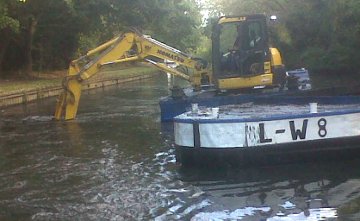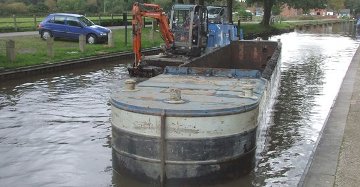MIGHT I comment on some recent narrowboatworld reports? asks Canal & River Trustee John Dodwell.
Sorry not to have done so before—one reason was that I was taking my boat to Stourbridge for the 50th anniversary commemoration of the 1962 'Battle of Stourbridge'. Lots of boats and even more people on the towpath there.
And then attending a presentation to the Welsh Assembly—where the display material showed boats, you'll be pleased to hear. I'm just back from the Royal Yachting Association/British Marine Federation Parliamentary reception, celebrating the Olympic sailing successes—somehow they managed to get a narrowboat on their display material too.
Respect has to be earned
I quite agree with (Steve Jenkin narrowboatworld 8th October) that respect is not a given, it has to be earned. I know it will take time for the new Trust to earn that respect. I see change being evolutionary, not revolutionary.
But I hope that users will come to appreciate that changes are happening. One example is the setting up of the Navigation Advisory Group—look at the navigation advisory group page on the Trust's website for the membership and the minutes of its first meeting last September. I'd have hoped that David Carden (narrowboatworld 15th October) would be pleased that, with the new Trust, the senior management recognises the benefits of asking boaters what they think.
Boats are key to the waterways, and the Trust knows the towpath public likes to see them. Another example of change is the waterway partnerships—whose minutes are also on the website. Yet another (but small) example is that I write these thoughts. The new Trust favours transparency. We'd rather people didn't use the Freedom of Information (FoI) procedure, but instead asked the relevant waterway manager etc—but we respect people have a right to use the FoI procedure. Just the same as (Pam Pickett—narrowboatworld 13th October) we accept—as long as it's not libellous—that people won't always agree with us.
Learn how the water control system works
I'm sorry that Ralph Freeman feels I misquoted him (narrowboatworld 10th October) but we seem to be agreed that he said the water rose in Aston Marina by seven inches. I asked Trust staff about his question on how much has been invested in water control etc on the whole length of the Trent & Mersey in the last five years and the answer is around £315,000, covering 23 different installations for water level, lock counter and flow monitoring. (Bear in mind that this type of work has been going on for many years and that some was done before the last five years).
This gives coverage of approximately 6.6 km per SCADA site. This can be compared with the Leeds & Liverpool Canal (7.3km per SCADA site) or the Kennet & Avon Canal (3.5km per SCADA site). These figures are an average and so it obviously doesn't mean SCADA devices are every 6.6km etc (4 miles in old money).
The general question of how water is monitored and controlled is not well known—I certainly learnt a lot after I became a Trustee. I didn't know it was called SCADA—which stands for Supervisory Control And Data Acquisition. Across the entire network, over £8 million has been spent on SCADA since 2002. I'd urge anyone who wants to get to grips with this subject to get in touch with a local Trust office and arrange an appointment to see how it works.
Now I don't want too much time taken away from normal work so maybe a few people can get together in a group... An alternative would be to go to one of the society etc meetings I read about in the waterways press as being addressed by Adam Comerford, the Trusts' Hydrology Manager (whose is based at Hatton).
Pam Pickett (narrowboatworld 20th October) asks me if I'd bet a neglected flood paddle she photographed against a £1.5m breach. If Pam can let me know where that paddle is, then I'll investigate.
 Dredging and spending for boats
Dredging and spending for boats
James Henry (narrowboatworld 7th October) had his doubts about the dredging which I listed. Well, see the photo of some of the £250k dredging last month at Hanwell I mentioned—taken below Osterley Lock.
See also the photo (below) of dredging at Fradley last month. This autumn £300,000 is targeted on spot dredging the Tame Valley Canal (Good!—I caught a large blade-full near Ocker Hill in September 2011.
 If you want to see the dredging, then the dates are 19th November to 21th December. For those in the Lincoln area, you can pop along to Brayford Pool; Three weeks dredging starts there on 5th November. And I can give you other examples.
If you want to see the dredging, then the dates are 19th November to 21th December. For those in the Lincoln area, you can pop along to Brayford Pool; Three weeks dredging starts there on 5th November. And I can give you other examples.
Now, we all know this isn't enough, and the Trust plans to spend more on dredging. I mentioned in my last post the development of a new 10 year dredging strategy (something which is possible now we are out of a ‘Government cuts' regime). This and the fact that a significant majority of the staff and their work and of the Trust's expenditure (getting on for £100m when you add it all up) is for the benefit of boaters—e.g. reservoir repairs, embankment maintenance, culvert relining, about 200 lock gates replaced every year, vegetation management, water supply protection and much more—show that the Trust really does care about boats. I'd be pleased if you spread this around.
The Contingency Fund
Orph Mable (narrowboatworld 10th October) suggested the contingency fund (if unspent) might be put in a deposit account for future emergencies. I'm not keen on that. I want to maximise the money spent on maintaining the canals and navigable rivers so I'm not keen on the 'put it in a bank account' idea. In recent years, breach repairs etc have been met from current income anyway.
The contingency concept works as follows. Each year a budget is drawn up on how the c. £150m anticipated income is to be spent; of this, £2m is put aside for contingencies. The plan is always to use that £2m. Underspending on maintenance would be a mistake. The only question is what it will be used for—this year on the Trent & Mersey breach and Mon & Brec repairs, last year on trees. So it's not a question of there being an unused balance at the end of one year which is carried forward to the next year.
Each year starts afresh with a new £2m contingency. As Orph Mable suggests, the Trust does think that emergencies can happen unexpectedly—one of the reasons for the contingency.
Specific purpose funds
I can reassure Orph Mable (narrowboatworld 10th October) that as with other charities the Trust will be showing in its accounts the use of Specific Purpose Funds where they are over £10k—so the Trent & Mersey Appeal will be shown.
Tell us if you don't get replies
David Carden (narrowboatworld 15th October) says some of the waterway managers are not interested in 'us navigators but would prefer voles, badgers and weeds to boats'. That's not my experience and I have met many of the Trust's key people over the last few months, particularly those at the front end of maintenance work.
There are also many unseen experts who add value to the work that boaters see on the ground. Of course, the Trust has to be mindful of its responsibilities for the environment, and much of it is dictated by legislation so it's all about finding the right balance. From what I have seen, the vast majority of Trust employees, whatever their role, understand the importance of finding that balance and work hard to achieve it. Look at the approx £100m spend I've mentioned earlier. That doesn't mean everyone will agree with all actions taken but I'm very concerned to read what David Carden says. Can he help me by giving examples?
(
David Carden also says he doesn't get replies to criticisms. All users' notifications of problems should get a reply—it helps if they are politely worded! If you don't get a reply, then email the waterway manager. If that doesn't work, then email:
Want to be an extra pair of eyes and ears?
David Hymers (narrowboatworld 22nd October) suggests regular boaters might become designated observers and asks for an email address to which comments can be sent. The easiest way to find that is to type into the search box of the Trust's website the waterway area you want, and there you'll see an email address and who the manager is; if you want to contact him/her direct, then it's the usual
The page also shows which waterways they deal with—if you're not sure where the boundaries are. Having the single email address David suggests would mean having a bod to service it—I'm not keen on increasing the overhead. Information sent to the waterway office will get a reply from a real person.
I've said it before and I'll say it again—I'd welcome boaters being an extra pair of eyes and ears for the Trust. Trust staff may well know of matters when you report them—but you may be the first to notice a problem, especially if it's underwater. All matters get noted and boater comments help in sorting out the priority in which matters are dealt.
And if you are able to offer Trust staff a journey on your boat, please do so. As you and I know, the perception from a boat is often different from the towpath.
Tailpieces
Did you hear about the sponsored car wash which led to £250 being raised for the Trent & Mersey Breach Appeal? Birkenhead YMCA each year take about 500 homeless and disadvantaged people on their boat on the Trent & Mersey. They have unofficially adopted the Dutton/Middlewich length and care for the mileposts and pick up litter—this has spin-off effects in changing attitudes to pollution and caring for their environment and helps their progression back to 'mainstream society'. Their guys were so anxious to do something about the breach that they raised £155 from a sponsored car wash with the YMCA making it up to £250 (see my post, narrowboatworld 5th October). Now, I reckon that's a really good example of how wide are the appeal and benefits of the waterways.
Have you signed up for the Trust's new 'Boaters Update'? At present, it goes to about 8,300 people. Because of the law, the Trust can only send it to people who give their details—so if you want to get it, tell
I was pleased to see David Lyneham-Brown (narrowboatworld 29th October) had given local Trust office details to a couple of potential volunteers. I fear his suggestion of all 35,000 licence holders being sent volunteering leaflets would mean a lot of paper being used but I'll ask about the renewal form telling people about downloading a form from the website.
The Trust is keen on having volunteers—remember that, apart from my personal knowledge of what volunteers can do, we also have as Trustees the deputy director of Oxfam and the recently retired head of the WRVS (65,000 volunteers). Increasing the number of volunteers will be part of the evolution I mentioned above.
